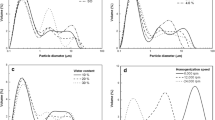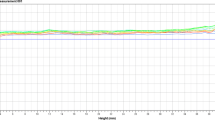Abstract
Cupuassu fat is a good candidate for partial substitution of cocoa butter in many products, including emulsions. However, for such use it is necessary to know the characteristics of the products prepared with cupuassu fat. Therefore, the main goal of this work is to characterize emulsions prepared with cupuassu fat using the surfactants Tween® 60, Tween® 80 and Tween® 85 as emulsifiers. The emulsions were prepared at 43 °C with addition of 0.5 or 1.5 % (w/v) of surfactant and compared with an emulsion without surfactant. All emulsions were analysed by conductivity, stability, pH, optical microscopy, rheology and oxidative stability. It was verified that the emulsions prepared with Tween® 60 and Tween® 80 have higher stability, smaller droplet size and higher apparent viscosity. Also, these properties are positively influenced by the concentration of the surfactant. On the other hand, emulsions prepared with Tween 85 or without surfactant reached unsatisfactory results. The rheological behaviour of the emulsions was adequately described by both Herschel-Bulkley and Mizhari-Berki models revealing pseudoplastic character. These emulsions also present strong gel behaviour, with storage modulus higher than loss modulus. In conclusion, cupuassu fat can be used as oil phase for emulsions products and this characterization helps to understand their behaviour in order to increase their use in food industry.






Similar content being viewed by others
References
Azevedo ABA, Kopcak U, Mohamed RS (2003) Extraction of fat from fermented Cupuaçu seeds with supercritical solvents. J Supercrit Fluids 27:223–237
Salgado JM, Rodrigues BS, Donado-Pestana CM et al (2011) Cupuassu (Theobroma grandiflorum) peel as potential source of dietary fiber and phytochemicals in whole-bread preparations. Plant Foods Hum Nutr 66:384–390
Cohen KDO, Jackix MDNH (2005) Estudo do liquor de cupuaçu. Ciência e Tecnol Aliment 25:182–190
Gilabert-Escrivá MV, Gonçalves LAG, Silva CRS, Figueira A (2002) Fatty acid and triacylglycerol composition and thermal behaviour of fats from seeds of Brazilian Amazonian Theobroma species. J Sci Food Agric 82:1425–1431
Alves RM, Sebbenn AM, Artero AS et al (2007) High levels of genetic divergence and inbreeding in populations of cupuassu (Theobroma grandiflorum). Tree Genet Genomes 3:289–298
Quast LB, Luccas V, Kieckbusch TG (2011) Physical properties of pre-crystallized mixtures of cocoa butter and cupuassu fat. Grasas Aceites 62:62–67
Dantas L, Guerra M (2010) Chromatin differentiation between Theobroma cacao L. Genet Mol Biol 33:94–98
Lannes SCDS, Medeiros ML (2003) Processamento de achocolatado de cupuaçu por spray-dryer. Rev Bras Ciências Farm 39:115–123
Silva JC, Plivelic TS, Herrera ML et al (2009) Polymorphic phases of natural fat from Cupuassu (Theobroma grandiflorum) beans: a WAXS/SAXS/DSC study. Cryst Growth Des 9:5155–5163
Esteller MS, Zancanaro Júnior O, Lannes SCDS (2006) Bolo de “chocolate” produzido com pó de cupuaçu e kefir. Rev Bras Ciências Farm 42:447–454
Luccas V, Kieckbusch TG (2006) Comparative study of the polymorphism of cupuassu fat and cocoa butter using differential scanning calorimetry. Brazilian J Food Technol 9:63–68
Protonotariou S, Evageliou V, Yanniotis S, Mandala I (2013) The influence of different stabilizers and salt addition on the stability of model emulsions containing olive or sesame oil. J Food Eng 117:124–132
Züge LCB, Haminiuk CWI, Maciel GM et al (2013) Catastrophic inversion and rheological behavior in soy lecithin and Tween 80 based food emulsions. J Food Eng 116:72–77
Bellalta P, Troncoso E, Zúñiga RN, Aguilera JM (2012) Rheological and microstructural characterization of WPI-stabilized O/W emulsions exhibiting time-dependent flow behavior. LWT Food Sci Technol 46:375–381
Lupi FR, Gabriele D, De Cindio B et al (2011) A rheological analysis of structured water-in-olive oil emulsions. J Food Eng 107:296–303
S I, Ünlü CH, O A, Güngör N (2006) Rheology and structure of aqueous bentonite—polyvinyl alcohol dispersions. Bull Mater Sci 29:449–456
Barnes HA (1994) Rheology of emulsions—a review. Coll Surf 91:89–95
Steffe JF (1996) Rheological methods in food process engineering, 2nd ed
Azizkhani M, Zandi P (2010) Effects of some natural antioxidant mixtures on margarine stability. World Acad Sci Eng Technol 69115:93–96
Gramza-Michałowska A, Stachowiak B (2010) The antioxidant potential of carotenoid extract from Phaffia rhodozyma. Acta Sci Pol Technol Aliment 9:171–188
Metrohm (2013) Metrohm application bulletin 204/2e. Oxidation stability of oils and fats—Rancimat method. Herisau, Switzerland
Chung C, McClements DJ (2014) Structure-function relationships in food emulsions: improving food quality and sensory perception. Food Struct 1:106–126
Dickinson E (2009) Hydrocolloids as emulsifiers and emulsion stabilizers. Food Hydrocoll 23:1473–1482
McClements DJ (1999) Food emulsions: principles, practice and techniques. CRC Press, Boca Raton
Pourreza N, Rastegarzadeh S (2004) Kinetic spectrophotometric determination of Tween 80. Talanta 62:87–90
Samanta S, Ghosh P (2011) Coalescence of bubbles and stability of foams in aqueous solutions of Tween surfactants. Chem Eng Res Des 89:2344–2355
McClements DJ, Weiss J (2005) Lipid emulsions. In: Shahidi F (ed) Bailey’s Ind. Oil Fat Prod., 6th ed. John Wiley & Sons, Inc, pp 457–502
Al-Bawab A, Al-Zamar T, Friberg SE (2007) An “O/S”’ emulsion in a system containing Tween 80 surfactant and hexadecane oil. J Surfactants Deterg 10:195–200
Ping A, Geng P, Wei X et al (2015) Rheological properties of wormlike micelles formed in aqueous systems of 3-Alkoxy-2-hydroxypropyl trimethyl ammonium bromides in the presence of sodium octanoate. J Surfactants Deterg 18:1117–1126
Züge LCB, Silva VR, Hamerski F, et al. (2015) Emulsifying properties of sericin obtained from hot water degumming process. J Food Process Eng
Santana RC, Perrechil FA, Cunha RL (2013) High- and low-energy emulsifications for food applications: a focus on process parameters. Food Eng Rev 5:107–122
Thakur RK, Villette C, Aubry JM, Delaplace G (2008) Dynamic emulsification and catastrophic phase inversion of lecithin-based emulsions. Coll Surf A Physicochem Eng Asp 315:285–293
Roland I, Piel G, Delattre L, Evrard B (2003) Systematic characterization of oil-in-water emulsions for formulation design. Int J Pharm 263:85–94
Denkov ND, Tcholakova S, Ivanov IB, Campbell B (2002) Methods for evaluation of emulsion stability at a single drop level. World Congr Emuls 2–10
AOCS (1997) Official methods and recommended practices of the american oil chemists’ society, 5th edn. AOCS Press, Champaign
Hait SK, Moulik SP (2001) Determination of Critical Micelle Concentration (CMC) of nonionic surfactants by donor–acceptor interaction with iodine and correlation of CMC with Hydrophile-Lipophile Balance and other parameters of the surfactants. J Surfactants Deterg 4:303–309
Lawrence MJ, Rees GD (2012) Microemulsion-based media as novel drug delivery systems. Adv Drug Deliv Rev 64:175–193
Fanun M (2010) Properties of microemulsions with mixed nonionic surfactants and citrus oil. J Colloid Interface Sci 369:246–252
Cottrell T, Van Peij J (2014) Emulsifiers in food technology. Emuls Food Technol Second Ed
Yaghmur A, Aserin A, Garti N (2002) Phase behavior of microemulsions based on food-grade nonionic surfactants: effect of polyols and short-chain alcohols. Coll Sur A Physicochem Eng Asp 209:71–81
Dickinson E (2003) Hydrocolloids at interfaces and the influence on the properties of dispersed systems. Food Hydrocoll 17:25–39
Yutani R, Teraoka R, Kitagawa S (2015) Microemulsion using polyoxyethylene sorbitan trioleate and its usage for skin delivery of resveratrol to protect skin against UV-induced damage. Chem Pharm Bull 63:741–745
Tcholakova S, Denkov ND, Ivanov IB, Campbell B (2002) Coalescence in beta-lactoglobulin-stabilized emulsions: effects of protein adsorption and drop size. Langmuir 18:8960–8971
Pelipenko J, Kristl J, Rošic R et al (2012) Interfacial rheology: an overview of measuring techniques and its role in dispersions and electrospinning. Acta Pharm 62:123–140. doi:10.2478/v10007-012-0018-x
Rousseau D (2000) Fat crystals and emulsion stability - A review. Food Res Int 33:3–14
Lannes SCS, Medeiros ML, Gioielli LA (2004) Rheological properties of cupuassu and cocoa fats. Grasas Aceites 55:115–121
Ghosh S, Rousseau D (2011) Fat crystals and water-in-oil emulsion stability. Curr Opin Colloid Interface Sci 16:421–431
Masmoudi H, Le Dréau Y, Piccerelle P, Kister J (2005) The evaluation of cosmetic and pharmaceutical emulsions aging process using classical techniques and a new method: fTIR. Int J Pharm 289:117–131
Nowicki J (2010) Emulsion properties and phase equilibrium and of new asymmetric gemini surfactants consisting of fatty acid esters of polyethoxylated alcohol or phenol. J Surfactants Deterg 13:195–199
Derkach SR (2009) Rheology of emulsions. Adv Coll Interface Sci 151:1–23
Gentile L, Behrens MA, Porcar L et al (2014) Multilamellar vesicle formation from a planar lamellar phase under shear flow. Langmuir 30:8316–8325
Gentile L, Oliviero Rossi C, Olsson U (2012) Rheological and rheo-SALS investigation of the multi-lamellar vesicle formation in the C 12E 3/D 2O system. J Coll Interface Sci 367:537–539
Acknowledgments
We gratefully acknowledge the financial support provided by CAPES (Coordination for the Improvement of Higher Education Personnel) to carry out this work, the Graduate Program in Food Engineering (Federal University of Paraná, Brazil), and FECAT for donation of cupuassu fat. Also thank the National Research Council of Brazil - CNPq No. 476950/2013-9, Araucaria Foundation (PRONEX-Carboidratos), Rede Nanoglicobiotec-MCT/CNPq – No. 564741/2010-8, and the support of Professor Dr. J.L.M.S., research member of CNPq (No. 306949/2012-1).
Author information
Authors and Affiliations
Corresponding author
Ethics declarations
Conflict of interest
The authors have declared no conflict of interest.
About this article
Cite this article
Teixeira, G.L., Züge, L.C.B., Silveira, J.L.M. et al. The Impact of Polyoxyethylene Sorbitan Surfactants in the Microstructure and Rheological Behaviour of Emulsions Made With Melted Fat From Cupuassu (Theobroma grandiflorum). J Surfact Deterg 19, 725–738 (2016). https://doi.org/10.1007/s11743-016-1820-0
Received:
Accepted:
Published:
Issue Date:
DOI: https://doi.org/10.1007/s11743-016-1820-0




